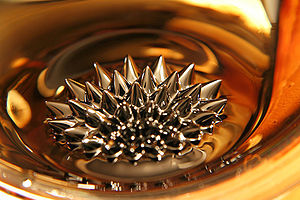Ferrofluid
Ferrofluids are dispersed colloidal micro magnetic particles mixed with a liquid carrier fluid. These particles are coated with a surfactant that prevents them from clumping close together. When the fluid comes in contact with a magnetic field, it reacts to it by reaching towards it. Ferrofluid volume makeup is usually gauged around 5% magnetic solid, 10% surfactant and 85% carrier. [1]
Properties
The magnetic particles such as iron and other magnetic materials within the fluid are sized around 100A or 10nm. These magnetic particles are what cause the fluid to stand. A stabilizing dispersing agent that decreases surface tension of liquid (surfactant) covers each particle. This prevents them from clustering up even when a strong magnetic field is used on the ferrofluid.
The surfactant fights against the van der Waals forces and magnetic forces to stay together. When magnetic forces are introduced, the ferrofluid reacts instantly and orients along the magnetic fieldlines creating what look like spikes protruding from it. When no magnetic field is present, the magnetic particles within the fluid are randomly dispersed.[2]
Uses
Ferrofluid doesn't just have one main use, but because of its unique characteristics it has many applications. It has been used to enhance the performance of many other products by solving a wide variety of many technical problems. Some of the areas that are targeted for enhanced application are mechanical areas such as seals, bearings, and dampers. Others are electromechanical areas such as loudspeakers, stepper motors, and sensors. In testing of nondestructive materials purposes, they target things such as magnetic tapes, stainless steel, and wind turbine blades.
A few things are tweaked and adapted to prove its best potential for each product ferrofluid is placed into. It must account for things such as optimizing viscosity, thermal conductivity, environment, evaporation pressures and chemical compatibility. Some of the conditions that are asked of it to preform in can get to be extreme, such as withstanding nuclear radiation without breaking down. It is expected to normally perform in high temperatures of 150°C continuously and at 200°C intermittently. At low temperatures, it can drop down to -20°C in winter conditions and even lower in space environments at -55°C. Engineering weights heavily on the fluids advancement, and there is immense future potential. [3]
Creator
Since 1968, Ferrotec Corporation has supported and led further development of Ferrofluidic® tech advancements. Ferrotec Corporation was also formerly known as Ferrofluidics. They are the worldwide leader in production of ferrofluid and ferrofluid development. They have worked closely with other companies to introduce ferrofluid into their next products for better improvements. Laboratories are set up in the U.S. and across the seas in Japan. [4]
Entertainment
Above all else, ferrofluid is a great form of entertainment. It does does have many abilities to improve advancements in science, but it also has the ability for simple enjoyment. It has unique characteristics that attracts people because there is nothing quite like it. That artistic eye of many have foreseen its capabilities and have use it to their advantages. In Japan, Sachiko Kodama is known for her amazing talent in bringing out the artistic feel of ferrofluid. She is just one of many who use this as a artistic medium.
Video
References
- ↑ Author-Unknown. Technology. Ferro Tec. Web. © 2001–2012 Copyright.
- ↑ Author-Unknown.Technology. Ferro Tec. Web. © 2001–2012 Copyright.
- ↑ Author-Unknown. Technology. Ferro Tec. Web. © 2001–2012 Copyright.
- ↑ Unknown-Author. Page-Title. Ferro Tec. Web. © 2001–2012 Copyright .
- ↑ Unknown-Author. Ferrofluid: Weird and Weirder. Scienceray. Web.copyright 2012.
- ↑ Unknown-Author. Ferrofluid. Wikipedia. Web. last modified on 26 February 2012 at 15:51.
